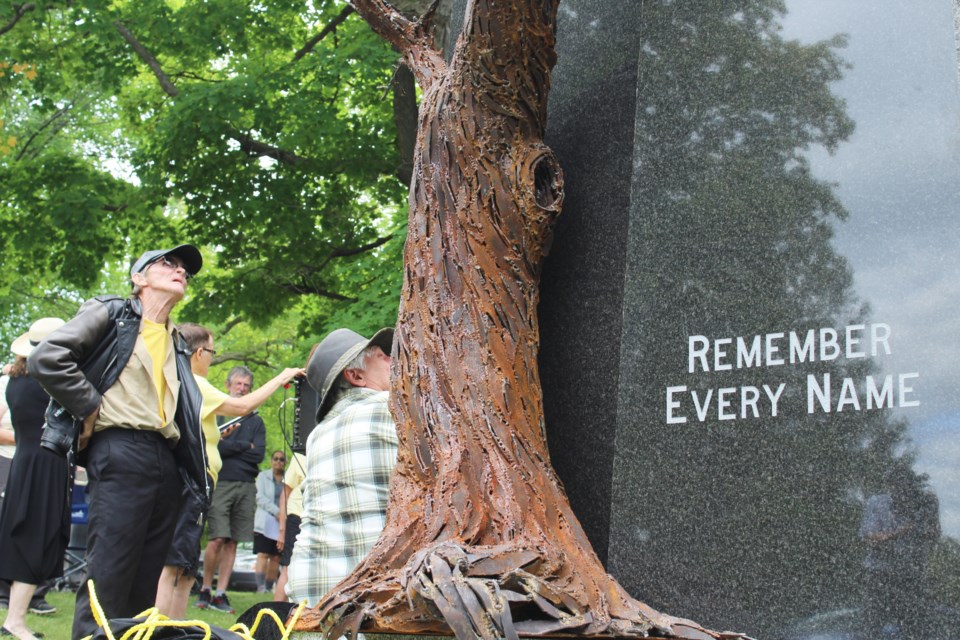BarrieToday welcomes letters to the editor at [email protected]. Please include your daytime phone number and address (for verification of authorship, not publication). The following is an open letter to Angela White, executive director of the Indian Residential School Survivors Society; Perry Bellegarde, national chief of the Assembly of First Nations; and Cindy Blackstock, executive director of the First Nations Child and Family Caring Society.
*******************
When we heard about the children buried in unmarked graves at the Kamloops (B.C.) Residential School, we were very sad but not surprised. We have always believed survivors.
The tragic truth is that many more bodies will be found at residential schools and other places of incarceration across Canada. We wanted to tell you how sorry we are, but we also hope we might share experiences and work together.
We are survivors, too — forced into government-run institutions not because of our race, but because we were judged as inferior, labelled with developmental disabilities. Some had significant disabilities and others had none at all, but were misunderstood because we were born into poverty or broken homes.
Admitted as children — even as babies — we were expected to spend the rest of our lives in institutions, where some died quite quickly and others suffered for years.
Instead of going to residential schools, some Indigenous children were sent to these provincial institutions, where they were often denied access to schooling, put to work immediately and treated especially badly. Indigenous institution survivors often lost connection to their communities.
Institution survivors tell about neglect, threats, punishments and abuse that sound very similar to what Indigenous students experienced in residential schools. Children and adults were forced to provide slave labour that saved the government money. All were traumatized by removal from their families and society.
Like First Nations people, we had to have a class-action lawsuit against the government to achieve a very small measure of recognition.
Hearing about unmarked graves of Indigenous children, we think the name of our group reflects a goal we share — to “Remember Every Name.” We gather regularly at the cemetery of the first and largest institution in Canada — Huronia Regional Centre (HRC) located in Orillia, Ont. — to listen to the stories of survivors, to honour the babies, children and adults who died and to comfort each other with rituals, songs and solidarity. We commissioned an artist to create a beautiful memorial monument, which is pictured at https://www.remembereveryname.ca, where you can find out more about us.
We acknowledge that the HRC Cemetery is on the traditional territory of the Anishinaabe Peoples and we wish to recognize and respect the long history of First Nations and Métis Peoples in Ontario. From 1903 to 2015, archeologists have reported finding evidence of previous Indigenous villages and cemeteries on the institution grounds.
Our class-action required the Ontario government to maintain HRC’s overgrown and neglected cemetery. Although institution staff had already built a monument that says there were “more than 2,000 people… whose life journey ended here,” and although their own 2015 archeology report said the number of burials was unknown, the Ontario government now contradicts itself and says only 1,379 people were buried.
Most graves are unmarked; some are marked with numbered stones and only the most recent have proper markers with names and years of birth and death. The government has not acknowledged that its staff removed hundreds of grave markers, turned them over to hide the numbers and used them as paving stones. When some were found, staff did not return them to their proper places.
The government has also denied that they disturbed many graves by digging a sewage pipe through rows of burials to establish a septic system in the cemetery. People who know what happened have kept silent.
We hope we can assist you by sharing our experience with ground-penetrating radar (GPR), in which we were assisted by Jerry Melbye, PhD, a distinguished North American forensic anthropologist.
The government surveyed the whole HRC Cemetery, but would not release to the survivors GPR images of the sewer pipe and surrounding burials. The Ontario government refused Dr. Melbye’s pro bono offer to investigate.
Further searches beyond the cemetery are needed because survivors have always said that people were buried elsewhere on the grounds. Investigations should be done at 18 similar Ontario institutions and at others like them across Canada.
Our experience reinforces why First Nations must retain absolute control over burial investigations and reparations at residential schools. We have seen how government hid the truth and excluded survivors from access to information and participation in decisions.
Please connect with us so that we can learn from each other’s experiences. We are reaching out in solidarity, to reveal the truth and Remember Every Name.
Sincerely,
Huronia Regional Centre survivors:
Betty Bond
Antoinette Charlebois
Harold Dougall
Beverley Link
Brian Logie
Cindy Scott
Marie Slark
Carrieanne Tompkins
Remember Every Name allies:
Jim and Marilyn Dolmage
Debbie Vernon
Mitchell Wilson
*******************



